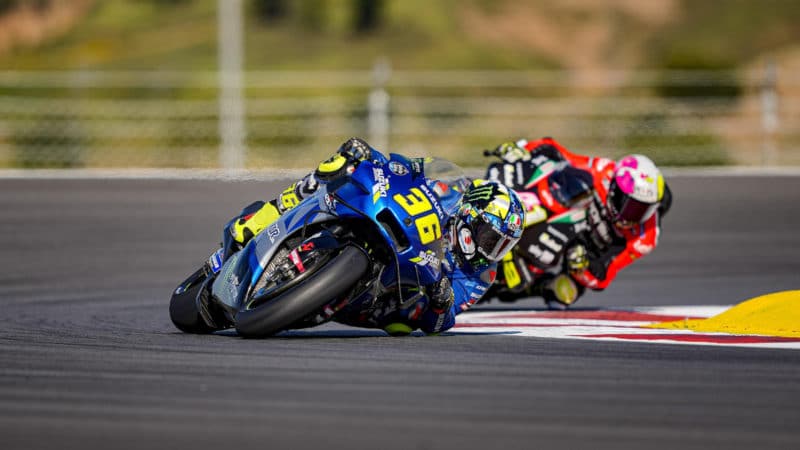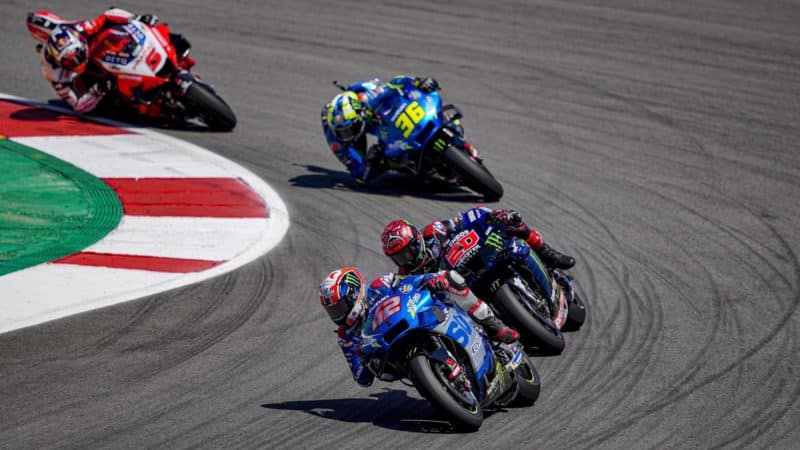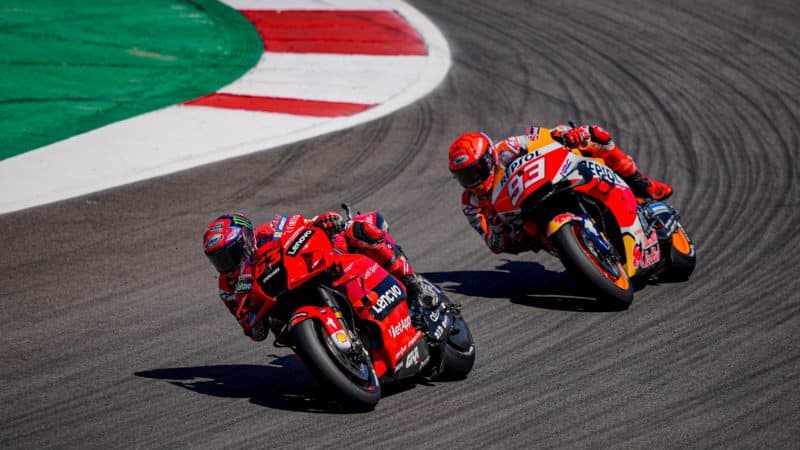Quartararo had proved in practice that he was faster, but Rins had tried to negate that gap with a little derring-do.
“Yamaha have made a big step since last year,” said Quartararo, a comfortable championship leader after three races, just like last year. “Also, I have learned a lot. Last year when the bike wasn’t going so great I was always feeling negative. Now I’ve totally changed – always thinking positive. I arrived here knowing the bike is working well and even if a few things didn’t work well I only thought about what’s working well.
“To set the pace we set today wasn’t easy but I was focused and after practice we analysed the times pretty well and we knew we were a bit faster. In the middle of the race I was pushing so hard and I knew it was okay for us but I thought he might make a mistake. I don’t know how many laps he was right behind – 0.2, 0.3, 0.3 – but I wanted to escape and finally, although this wasn’t our goal, he made a mistake.”
Quartararo finished his post-race chat saying that 70% of success in bike racing is mentality. Mick Doohan said it was 90%, so maybe the youngster still has further to go.
The inline-fours had it all their own way around Portimao’s flowing curves, but it might’ve been different if Bagnaia hadn’t had to fight his way through from the luckless fourth row of the grid, which he shared with Oliveira and Viñales.
Bagnaia – who looks more like a diligent university student than a MotoGP star – is finally coming of age. He showed exceptional pace in the early stages of last season, thanks to his stunning corner speed – but then he started losing the front and crashing, so his confidence evaporated. Ducati knew what he was doing wrong and told him to work on it over the winter.
His problem was that he wasn’t working the front tyre hard enough from the moment he left pit lane in practice and in qualifying and from the moment the lights went out on Sunday. He was too wary of the tyre when it was cold, so he didn’t push hard enough, soon enough to get it hot, so he crashed because it wasn’t hot enough.

Mir heads Aleix Espargaro as he goes after the leaders
Suzuki
It was a huge leap of faith to change this mindset but he did it, working last winter with his VR46 academy colleagues aboard dirt trackers, minibikes and YZF-R6s. Now he nails the front tyre from the first corner – tricky but vital – and that’s made all the difference to his ability to fight during the all-important opening laps.
Bagnaia is also using a different swingarm this year. It’s a 2020 item but he never tried it last year because he was in too much of a mess to further confuse himself by trying new bits and pieces. Instead he needed to focus on himself, just like Quartararo. This swingarm gives him better feel, so he gets more information from the rear tyre, so he can feel the limit more easily and look after the rubber better.
Of course, 300 horsepower doesn’t hurt either. The Portimao straight is shorter than Losail but it’s still long enough for a Ducati to slingshot past any Suzuki or Yamaha that it might find in its way. This is one reason Ducati focuses so much on horsepower, because if the rider can pass rivals on the straight then he needs take fewer risks in the corners and can look after his tyres better.
And yet Bagnaia didn’t make all his passes with the throttle.
“I made a few overtakes in some corners where I thought it would be difficult,” said the 24-year-old Italian. “But we lost the possibility to fight for the win yesterday. The maximum for us was second and we achieved it, so we are happy.”
Jerez will be a big test for Ducati. The Desmosedici has always struggled there, so if it can do what it did at Losail and Portimao then the Bolognese brand may have found something with the GP21.
Joan Mir got to stand on the podium for the first time as world champion and exorcised the nightmare of Portimao 2020 when he qualified 20th and withdrew from the race while 19th. Those problems – an engine issue in practice and electronics settings issues throughout the weekend – are now well behind him.
Of course, if Johann Zarco hadn’t crashed out with six laps to go it would’ve been two Ducatis on the podium and no Suzuki. Zarco made a mistake exiting the high-speed uphill Turn Nine left-hander, which heads over a brow into the low-speed Turn Ten right. He shifted to first instead of second, which obviously increased engine-braking, which unsettled the rear, which overloaded the front. Zarco may have lost the championship lead but he once again proved his class.
The Portimao rollercoaster is certainly unforgiving – its up-and-down nature makes finding the correct machine balance incredibly complicated, so major set-up compromises have to be made, leaving the rider to make the difference. Over the three days the track claimed almost twice the victims of the previous race weekend at Losail, with more than double the number of crashes in the MotoGP race.




